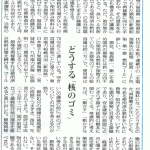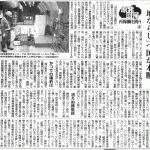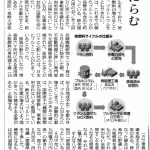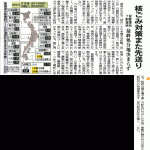Original Japanese written by staffer
The English below translated from the original Japanese by Heeday
The English translation edited by Rev. Dr. Henry French, ELCA
(Sources: articles of April 27th and August 12th, 2015 editions of the Fukushima Minpo newspaper and of July 10th and 11th editions of the Asahi Shimbun newspaper)
▼Click each image to enlarge it and read the caption.
“A luxury apartment without a lavatory.” That is the phrase often used in Japan to refer to nuclear power plants (NPPs) whose high-level radioactive waste, generated from the reprocessing of used nuclear fuel, have nowhere to “rest in peace.” The nation has been unable to secure a site for such waste – we are indeed “without a lavatory.”
Currently, therefore, having nowhere to store it, used nuclear fuel is simply resting in water pools inside NPPs all over Japan. Ever since the meltdown began, used fuel inside Fukushima Daiichi has been posing a serious danger.
Today, all in all, Japan’s NPPs are accommodating some 14,000t (15,435 short ton) of used fuel. This means the sum capacity of the temporary storage pools within all the NPPs of Japan is 70% occupied. The end is near. Thus, though the recently restarted Sendai NPP is estimated to have enough pool capacity to last another 10.7 years, more than a half of the other NPPs are expected to reach the limit of their storage pools within a decade should they too be restarted. The NPP closest to its storage limits is the Chubu Electric Power’s Hamaoka Plant, located in Shizuoka Prefecture. Should this plant be restarted, it will reach its storage pools’ limit in just a few years.
Even if most of the existing NPPs remain dormant for ever, it is still an urgent task to control and dispose of the used nuclear fuel already in their storage pools. It is a question of safety, environmental protection, etc.
The Japanese government, in May 2015, gave up on the traditional way of searching for a final disposal site – asking municipal governments to stand up voluntarily. The national government is now taking the initiative. Though the national government claims that it is searching, based on scientific analyses, for a place where used nuclear waste can be buried deep underground, one municipality after another is voicing their worries that the national government might force such a disposal site on them.
Now that Kyushu Electric Power has already restarted its Sendai NPP, we will have more nuclear waste in the years to come. This means we simply cannot afford to believe in a “later” solution to the problem of nuclear waste.
In Fukushima, they are having serious problems over where to bury the waste resulting from the meltdown of the NPP. Disposal of high-level radioactive waste is an urgent issue for the NPP industry to solve. As the voice of reason insists, without such a solution no NPP should be allowed to restart.




